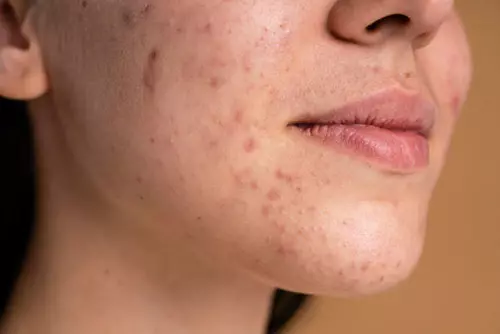Acne

Acne is a common, treatable skin condition normally associated with adolescents. In fact, 85% of teen boys and girls suffer from acne. However, acne also affects children and adults of all ages. 51% of women in their 20s, and 35% of women in their 30s suffer from acne.
Acne can be disfiguring, affects self-esteem and confidence, and can lead to significant social and emotional distress. Studies report that it can trigger depression and anxiety. However, there are many effective treatments that can help you gain control of your acne.
Acne encompasses pimples (pustules), blackheads, white heads, bumps, cysts, papules and nodules. Typically, it appears in the T zone, the area between the forehead, nose and chin, but can also develop on the back, neck, chest, shoulders, upper arms and buttocks. Permanent scarring can oftentimes be a residual effect of acne
What causes acne?
Acne begins in the hair follicles and oil glands. Each pore has a hair follicle and an oil gland. Skin cells die and are usually sloughed off, but when the pore is clogged by an accumulation of dead cells stuck together with sebum (oil) it creates the perfect environment for bacteria to grow and thrive. The result is a clogged pore that may become a blackhead or a white head. When the clogged pore becomes infected and inflamed it is called a papule. When the papule becomes filled with pus it is called a pustule. When the inflammation is deep in the skin it causes a cyst or nodule.
Acne is also the result of your genetics and hormones. Hormone changes during pregnancy and menopause, and stress play a role. During adolescence, the sex hormones surge and stimulate the production of sebum which results in oily skin that attracts skin bacteria. Other contributing factors include stress, a change in climate, some medications, occlusive cosmetics, and diet. Recent research reports that skim milk and skim milk products, carbohydrate-rich foods, and refined sugars can worsen acne. Avoid sharing makeup, sleeping with makeup on, washing too frequently, or scrubbing which can irritate the skin causing breakouts, and do not pop or squeeze acne.
How is acne treated?
The goal is to unclog pores with treatments that remove dead skin cells, called exfoliation; to reduce acne bacteria with antibiotics and topical treatments; and to normalize oil gland production. Early treatment is the most effective way to prevent severe acne and scarring.
First and foremost, we will teach you how to gently and effectively clean your skin to avoid irritation, prevent clogged pores, maintain hydration and retain the skin barrier.
Medical treatments often include one or more medicines and treatments used together:
- Topical retinoids to normalize oil production and unblock pores
- Topical antibiotics and benzoyl peroxide to kill acne bacteria
- Topical salicylic acid and glycolic acid to exfoliate the skin
- A good sunblock made for acne prone skin to prevent hyperpigmentation from inflammation, and the sun.
- In more severe cases oral medications may be necessary. This may include antibiotics, Accutane (isotretinoin), oral contraceptives and spironolactone.
- Exfoliation with chemical peels or microdermabrasion can clear acne and reveal healthier, brighter skin.
- Acne cysts are treated with steroid injections.
- Photodynamic Therapy is a light-based treatment to clear active acne. Treatments shrink the oil glands. It is very effective to treat severe acne that does not respond to medications. Treatments can control acne formation and prevent scarring.
- Intense pulsed light (IPL) treatments kill the bacteria that lead to acne.
Not all treatments work for everyone. Trial and error will help to find what works for you.


